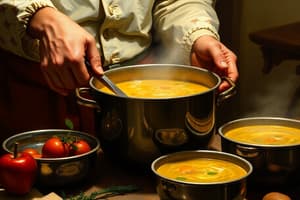Podcast
Questions and Answers
Which of the following is NOT a thickening agent used in cream soups?
Which of the following is NOT a thickening agent used in cream soups?
- Cornstarch slurry
- Roux
- Egg wash (correct)
- Beurre manié
Which type of poultry bird is a surgically desexed male chicken usually under 8 months of age?
Which type of poultry bird is a surgically desexed male chicken usually under 8 months of age?
- Roaster
- Capon (correct)
- Stag
- Cock
What is the name for a young immature pigeon of either sex with extra tender meat?
What is the name for a young immature pigeon of either sex with extra tender meat?
- Fryer
- Duck
- Squab (correct)
- Roaster
Which of the following is NOT a common cut of a whole chicken?
Which of the following is NOT a common cut of a whole chicken?
What breed of duck is noted for its tender and flavorful meat, and originated from China?
What breed of duck is noted for its tender and flavorful meat, and originated from China?
Which cut of chicken includes the wing?
Which cut of chicken includes the wing?
What is the leg whole chicken?
What is the leg whole chicken?
Which part of the chicken leg is the drumstick?
Which part of the chicken leg is the drumstick?
What is a key feature of persuasive writing?
What is a key feature of persuasive writing?
Which type of academic writing aims to inform readers about a topic?
Which type of academic writing aims to inform readers about a topic?
What is the purpose of using repetition in persuasive writing?
What is the purpose of using repetition in persuasive writing?
What is a boneless, skinless thigh?
What is a boneless, skinless thigh?
What is the primary thickening agent used in a béchamel sauce?
What is the primary thickening agent used in a béchamel sauce?
Which type of poultry bird is commonly used to make a white stock?
Which type of poultry bird is commonly used to make a white stock?
What is the most common cut of chicken used in poultry dishes?
What is the most common cut of chicken used in poultry dishes?
Which breed of duck is known for its rich, flavorful meat and ability to produce foie gras?
Which breed of duck is known for its rich, flavorful meat and ability to produce foie gras?
What is the primary thickening agent used in a velouté sauce?
What is the primary thickening agent used in a velouté sauce?
Which type of poultry bird is commonly used to make a brown stock?
Which type of poultry bird is commonly used to make a brown stock?
Flashcards are hidden until you start studying
Study Notes
Poultry Cuts
- Whole Leg: drumstick-thigh combination, does not contain a portion of the back
- Boneless, Skinless Leg: whole chicken leg with skin and bone removed
- Thigh: portion of the leg above the knee joint
- Boneless, Skinless Thigh: thigh with skin and bone removed
- Drumsticks: lower portion of the leg quarter between the knee joint and the hock
Academic Writing
- 3 types: Informative, Persuasive, and others
- Informative Writing: educates readers about a topic, answers 5 W's
- Features: Tone, Clarity, Transitional Words
- Persuasive Writing: aims to convince readers to think, feel, and act in a certain way
- Techniques: Rhetorical Questions, Repetition, Bandwagon, Appeal to Emotion, Appeal to Authority
Soup Preparation
- Classification of Soup: Clear, Thick, Cream, Purée, Bisque, Chowder, Velouté
- Clear Soup: based on a clear, unthicken broth or stock
- Thick Soup: soup that is thickened to provide a heavier consistency
- Cream Soup: soup thickened with roux, beurre manié, liaison, or other thickening agents
- Bouquet Garni: assortment of fresh herbs and aromatic ingredients
Poultry Classification
- Broiler or Fryer: young chicken, usually 9 to 12 weeks of age
- Roaster: 5 to 6 months of age
- Capon: surgically desexed male chicken, usually under 8 months of age
- Stag: male chicken, under 10 months of age
- Hen or Stewing Chicken: mature female chicken, more than 10 months of age, also called layer
- Cock or Roaster: mature male chicken with coarse skin
- Jumbo Broiler: a large chicken, about 4kg
Other Poultry
- Peking Duck: a breed of duck originating from China, noted for its tender and flavorful meat
- Duck or Itik: available and popular in many towns
- Squab: young immature pigeon of either sex, with extra tender meat
Whole Chicken Cuts
- Whole Chicken: marketed either fresh or frozen
- Halves: the bird is split from front to back
- Breast Quarters: halves may be further cut into which include the wings
- Split Breast: a breast quarter with the wing removed
- Split Breast without Back: a breast quarter with wing and back portion removed
- Boneless/Skinless Breast: split breast that has been skinned and deboned
Sauces
- Sauce: a flavorful liquid, usually thickened, used to season, flavor, and enhance other food
- Salus: French term for sauce, derived from the Latin word, meaning salted
- Garum: a form of fermented fish sauce
- 6 types of basic sauces: Mayonnaise, Hollandaise, Tomato Sauce, Brown Sauce, Velouté, Béchamel
Stocks
- Stock: most basic preparation found in a professional kitchen
- Classification of Stock: Chicken, White, Brown, Fish
- Chicken Stock: made from chicken bones
- White Stock: made from beef or veal bones
- Brown Stock: made from beef or veal bones that have been browned in an oven
- Fish Stock: made from fish bones and trimmings left over after filleting
- Ingredients in preparing stocks: Bones, Mirepoix, Acid Product
Studying That Suits You
Use AI to generate personalized quizzes and flashcards to suit your learning preferences.




